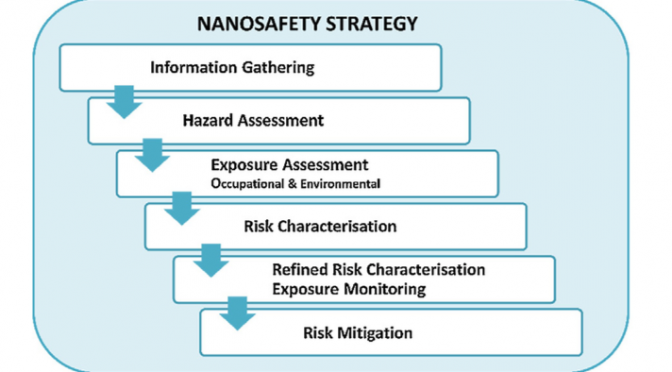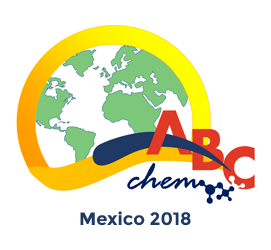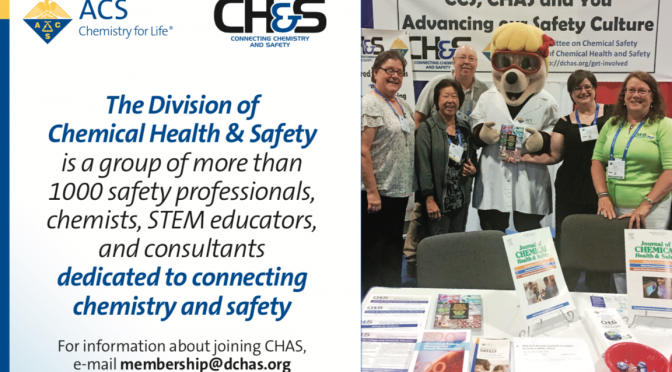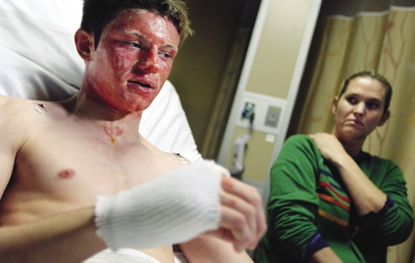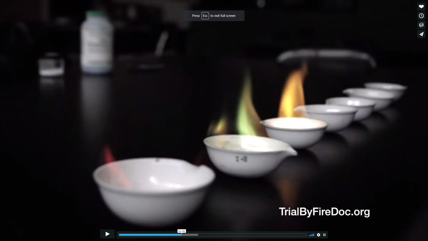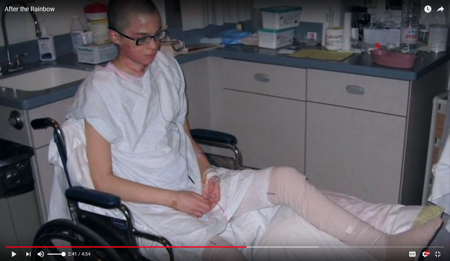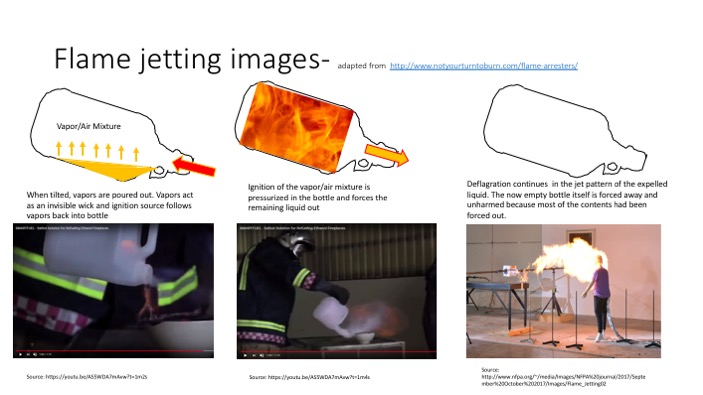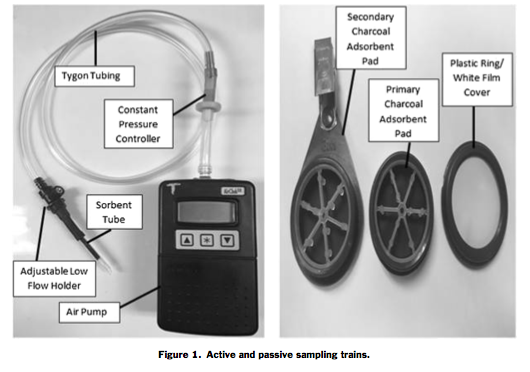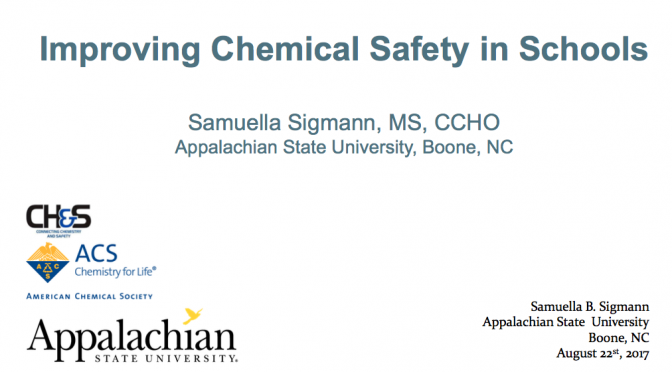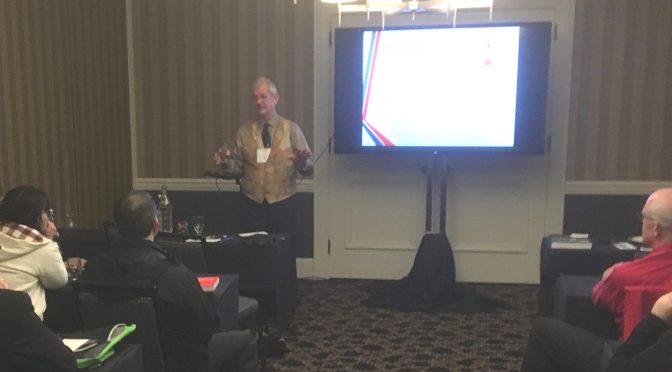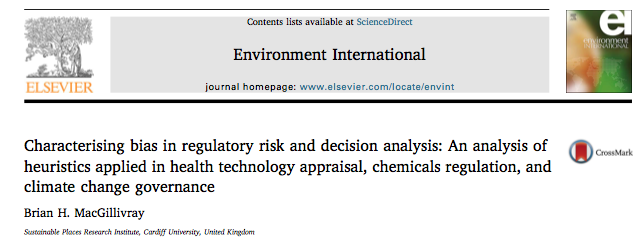INFORMATION FOR NEW CHAS MEMBERS AND VOLUNTEERS
Safety and the American Chemical Society (ACS)
The ACS is a very large organization managed by a combination of full-time professionals and active volunteers. Information regarding how the ACS operates can be found on the ACS website (https://www.acs.org/content/acs/en/about/governance.html) and is not discussed in detail in this document. With respect to safety, the ACS has two groups dedicated to supporting the safe use of chemistry (particularly, but not exclusively, in the laboratory setting) the Committee on Chemical Safety (the CCS) and the Division of Chemical Health and Safety (DCHAS).
The CCS is part of the ACS governance structure and provides policy recommendations for and peer review of ACS safety outreach materials. Membership is managed by the ACS Committee on Committees.
DCHAS is a technical division which addresses emerging chemical safety issues, broadly construed, and supports research into these issues. Membership in the Division is open to all chemists and chemical safety professionals and DCHAS takes the lead in organizing technical symposia and publishing research on the topics. There is significant overlap between CCS and DCHAS, both in terms of professional interests and people participating in the activities of each. The goal of this document is to help people interested in participating in ACS safety discussions identify the best place to develop these interests.
ACS National Meetings
There are two ACS National Meetings scheduled every year, one in the spring (March or April) and one in the fall (August or September). The official dates for each meeting extend from Sunday through the following Thursday. Note that many meeting attendees arrive during the week before the meeting as there are meetings of many governance committees, the ACS Board of Directors meeting, and workshops conducted prior to the official start of the meeting.
CHAS workshops are normally offered on the Friday and Saturday just prior to each National Meeting. ACS staff usually arrive by the Wednesday before the meeting. The CCS usually holds a working meeting on Saturday Evening which is limited to members of the committee.
The busiest days of the meeting are Sunday, Monday, and Tuesday. Sunday has many presidential symposia and keynote speakers and the exposition opens on Sunday evening. Monday probably has the most symposia of any day at the meeting and features the exposition during the day, and SciMix in the evening (SciMix is a large poster session for all divisions and social event in the convention center). Tuesday is the last day of the exposition and another full day of symposia. On Tuesday evenings there is the ACS Awards Dinner during the Spring Meeting and the ChemLuminary Awards during the Fall Meeting. The Spring Awards Dinner recognizes individuals while the Fall ChemLuminary Awards event recognizes technical divisions and local sections.
On Wednesday morning of national meetings, the ACS Council Meeting takes place from 8:00 AM until noon. There are about 532 councilors (2015 count) and perhaps another 100-150 others (ACS staff, certain committee members, and non-councilor ACS members) who attend the meeting. Although this is, at best, 5% of the meeting attendees, the meeting activities decrease dramatically starting Wednesday morning. There is no exposition. The number of receptions and other evening events is very small on Wednesday, as a lot of attendees go home on Wednesday. There are symposia scheduled on Thursday morning and afternoon; attendance is often very low, especially in the afternoon symposia. The shuttle bus schedule is less frequent. There are no social activities or events. The symposia that are scheduled on Thursday are mostly from the large divisions.
Technical Programming at the National Meetings is organized by the technical divisions. Technical divisions develop symposia ideas and identify symposium organizers about 1 year prior to each national meeting. A “Call for Papers” goes out in C&E News approximately 9 months before the meeting and the online abstracts submission process opens to submissions approximately 8 months prior to the meeting and is open for about 2 months. After the abstracts submission window closes, Symposium organizers, Division Programming Chairs and ACS staff complete the scheduling process and develop a preliminary and final schedule.
Divisions must follow what is called “even programming.” Each of the five meeting days has morning and afternoon session scheduling, a total of 10 sessions. A division cannot schedule a second symposium in the same session unless they have scheduled symposia for all 10 sessions. Thus, larger divisions must program on Wednesday and Thursday before they can start scheduling second symposia in the same session. They cannot schedule a third symposium in a session until they have scheduled two symposia in all 10 sessions. Take a look at how many simultaneous symposia there are in ANAL, INOR, ORGN, PHYS, or PMSE.
CHAS Activities at National Meetings
The CHAS technical program is reflected in the ACS technical program (available at www.ACS.org) and a 2-page summary trifold is made available on http://www.dchas.org approximately one week prior to the meeting. This trifold, titled “CHAS-at-a-glance” provides information regarding the workshops, technical symposia and social events for the meeting. Paper copies are made available at the CHAS Booth in the Exhibit Hall and CHAS technical session information table. The following are highlights of typical events at the National Meetings for CHAS and CCS. These are also summarized in a calendar at the end of this document.
CHAS usually offers between two and six workshops at every national meeting. Those workshops take place on the Friday and Saturday before the meeting. Interested persons can obtain information and sign up through the www.dchas.org website. Members of CHAS and partner groups (CSHEMA, CHED) can attend these workshops for a discounted rate
On Sunday, the CHAS Executive Committee meeting and breakfast takes place from 8:00 a.m. until noon. All members, especially those interested in becoming more active in the division are welcome to attend the DCHAS EC meeting. The meeting agenda is posted on www.dchas.org approximately one week prior to the meeting. As there are many other Sunday morning activities, it is not unusual to see people coming and going throughout the meeting.
The CHAS technical program usually begins on Sunday afternoon. The CHAS Program Committee tries to avoid scheduling any technical symposia on Monday morning to avoid a conflict with the CCS membership meeting, but sometimes the “even programming” rules force CHAS to have a session on Monday morning. At a minimum, there are usually CHAS symposia scheduled for Monday afternoon and all-day Tuesday, although lately we have programmed through Wednesday afternoon. Almost all CHAS symposia are co-sponsored by CCS.
Keeping in mind that many CHAS volunteers are also active on the Committee for Chemical Safety (CCS), we note that the CCS Full Committee Meeting is on Monday morning at 8:30 AM with breakfast starting at 7:45 AM and runs until noon at the latest. If there are working task forces or other CCS working groups who need to do some specific work, CCS may have a working lunch after the full committee meeting. In light of this overlap, CHAS avoids programming at the same time as this meeting where possible.
Monday and Tuesday are full days of the Exposition in the convention center. CHAS and CCS co-sponsor a booth in the exposition; volunteers from both groups staff the booth (see “Booth Sign-up POLL” below for how to sign-up).
At most national meetings, Monday evening is the CHAS reception and social, usually from 5:00 or 5:30 until 7:00 or 7:30 PM. CCS members are welcome at the CHAS reception and all other activities. CHAS may partner with another division, most frequently SCHB (Small Chemical Business) or CHAL (Chemistry and the Law), as co-hosts of the social event. A co-hosted social may occur on Tuesday evening if our partner has a specific reason to hold it then, such as honoring a keynote speaker or award recipient from a Tuesday symposium.
On Monday night, SciMix is held from 8-10 pm. CHAS usually has 8-10 posters in the massive SciMix poster session. All members are invited to submit a poster to this event; to do so, submit an abstract as part of the technical program. The division always tries to have some presence at the ACS Sci-Mix, but has recently experimented with “daytime” poster sessions that is scheduled and collocated with the technical talks. When the poster session is scheduled with the technical sessions, poster presenters will be invited to re-post their poster during the SciMix sessions as well.
The schedules for the national meeting and for CHAS/CCS are quite full, especially during the key days of Sunday, Monday and Tuesday, when meeting attendance is the greatest.
CHAS activities outside of the National Meetings
The CHAS Executive Committee is active throughout the year, engaged in planning for the next meeting or pursuing projects to improve chemical health and safety throughout the chemical enterprise. Business is primarily conducted via monthly teleconference meetings that are organized by the chair. Elected officials, chairs and those working on CHAS projects (‘the executive committee’) are invited to participate in the monthly teleconference. Members interested in becoming more active in the division may also participate (contact someone on the EC to obtain current schedule/details).
In addition to the monthly EC teleconferences, additional teleconferences, and occasionally in-person meetings, are held to coordinate specific activities and projects. These projects are typically coordinated by the committee chair or project leader. Also- every January, the division sends a few newly elected officers or appointed committee chairs to the ACS Leadership Institute in Dallas. Attendees are selected by the EC based on their position or involvement with the committee. Periodically (5-10years), the division will conduct a strategic planning activity to develop long term plans which usually involves the executive committee and active volunteers.
General Information
A variety of resources are available for members and volunteers, each with specific intent
- DCHAS-L: This is the listserv that is provided to all CHAS members and some ACS and CCS officials. In addition to the latest chemical related incidents captured from Google, It is used as a forum to ask relevant safety based questions to leading subject experts, discuss safety concerns, post lessons-learned, post EHS employment opportunities, and announce CHAS activities to the entire division. The traffic level of this list is limited to 15 messages/day, but usually is 20 to 30 messages/week.
- DCHAS-EC: This is a listserv limited to the executive committee for conducting official CHAS business. All officers and chairs are automatically included in this discussion list as well as active volunteers. The traffic level of this list is less than DCHAS-L.
- dchas.org: This is the official website of the committee and is open to the public. It contains information for existing and prospective members (including presentations from National Meetings) as well as periodic updates of CHAS business including annual reports and tax filings, EC agendas and CHAS at a Glance
- CHAS Administrative Manual: This is the operational guide that defines how CHAS business is conducted. It is available on the CHAS website and is treated as a living document to address the evolving needs of the committee.
- Basecamp: This is a document sharing program that is utilized as a workspace for specific projects (for example, strategic planning). Various pages are set up for specific projects with access granted by project.
- Booth Sign-up and other polls: Individual polls are created usually via online polling apps and sent out to the entire DCHAS-L group prior to national meetings to request volunteers for the booth or other special activity at the National Meeting. Polling apps are also used to schedule special teleconferences.
- The Journal of Chemical Health and Safety is a benefit to all members as part of their annual dues. Members will receive the paper copy and have access to the electronic copy (current instructions for accessing the electronic copy can be found on dchas.org). All CHAS members are encouraged to submit articles to the Journal!
- The Cannabis Chemistry Subdivision (CANN) of CHAS develops programming and other activities focused on the emerging cannabis industry and endeavors to provide to information and other resources to chemists working in this area and ensure their health and safety. CANN business meetings are held Sunday morning after the CHAS-EC meeting, and programming is often scheduled on Monday of the national meeting.
Volunteers
- The Division of Chemical Health and Safety is reliant on volunteers for its survival – there are no permanent staff that serve the Division, although Divisional activities are often coordinated with ACS staff efforts. Volunteers can contribute by participating in specific projects or on committees, participation in technical programming as an organizer or presenter, or can assume assigned roles as a chair of one of the various committees or through service in an elected role (usually a 3-year commitment).
- Getting involved is easy– show up, either in person at a National Meeting or electronically via e-mail! One of the easiest ways to get involved is to attend the CHAS EC Breakfast on Sunday morning, a technical session or social event at the national meeting- walk up to a person wearing a “CHAS” shirt and ask how you can get involved (or tell us what you want to do). The incoming chair of the division is responsible for appointed chairs for the next calendar year, so this is a good person to start with (look this person up on the dchas.org website).
- Where to start: New volunteers typically start small- show up to a few events and listen in to how the activities work. You could also present a poster or give a talk, or sign up to volunteer at the booth with an experienced CHAS member. As you gain experience, you might decide to organize/co-chair a session or participate on a committee (just contact the committee chair and ask where they need help!). Heck, you might even want to run for an elected position. In any case- start early and talk to us…we’re not going to let anyone fail at this!
Volunteer Support:
- How do I get one of those cool shirts? CHAS Shirts are available at Land’s End (https://business.landsend.com/store/chas/) for purchase.
- Reimbursements for CHAS volunteer activities: Material support and expenses for sanctioned division activities are reimbursed by the division (supplies for workshops, costs for awards, etc.). Volunteers that serve in elected or appointed roles are provided some financial support (based on role) for their participation in national meetings or other official activities. The treasurer can provide guidance on how to claim expenses and what roles are supported so just ask!
More Information:
We realize that this guide is not comprehensive, so if there is anything else that you would like to know or see added to this document- please contact us and a member of the executive committee will help out. Thanks for taking the time to read this. We look forward to working with you in the future
- Original version issued January 2018 by Joe Pickel
Typical National Meeting Events for CHAS & CCS
|
|
Friday and Saturday |
Sunday |
Monday |
Tuesday |
Wednesday |
| Morning |
CHAS Workshops
[Registration Required] |
CHAS
Breakfast and EC Meeting [OPEN]
|
CCS Breakfast and Open Meeting [OPEN]
CHAS
Programming
Expo Booth manned
|
CHAS
Programming
Expo Booth manned |
CHAS
Programming
|
| Afternoon |
CHAS Workshops
[Registration Required]
|
CHAS
Programming
Expo Booth Set-up and opening session
|
CHAS
Programming
Expo Booth manned
|
CHAS
Programming
Expo Booth closing session and tear-down
|
CHAS
Programming
|
| Evening |
(Saturday) CCS Dinner & Subcommittee Meeting [CCS Members]
|
|
CHAS Reception & Social [OPEN]
ACS Sci Mix and CHAS Poster Session
|
|
|
